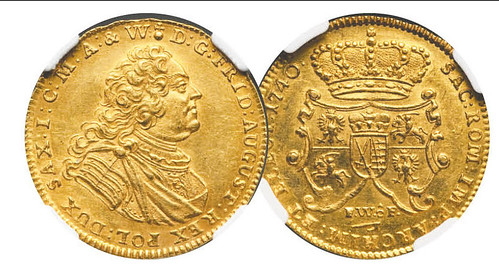
PREV ARTICLE
NEXT ARTICLE
FULL ISSUE
PREV FULL ISSUE
RARE SAXONY DOUBLE DUCAT FOUNDCanadian Coin News published a story of a great rarity discovered by a dealer. -Editor  What’s described as an “extremely rare unlisted date” of Saxony’s two-ducat gold coin, this a 1740-dated piece struck in what’s now Poland, was recently discovered by a Canadian dealer. After unknowingly purchasing the aforementioned piece in a bullion collection, the dealer, who wishes to remain anonymous, was unable to find the coin in any reference books. He contacted Peter McDonald, winner of the 2018 Charles D. Moore Professional Numismatic Award, for further information. “He found it in a lot of gold coins he purchased – a bullion collection – and he couldn’t identify it,” said McDonald. “He went through all his books, the whole nine yards, but there’s nothing on it per se, being an unlisted date,” said McDonald. “He recognized it looked like a Polish coat of arms on the reverse, but he thought, ‘What would that be doing on a German coin?’” The dealer sent McDonald images of the coin’s obverse and reverse, the latter of which features the “FWoF” mint mark, which indicates the coin was struck by Dresden mint master Friedrich Wilhelm o Feral (1734-64). “As soon as I saw the ‘FWoF’ mintmark, I knew it was good, but when he advised me it was 6.96 grams, I realized it was extraordinary.” This issue normally comes with a half- or one-ducat denomination, but a two-ducat example is “special,” McDonald said, adding he checked the Gold Coins of the World catalogue authored by Arthur and Ira Friedberg, and “this date was not noted.” Two-ducat coins dated 1735-39 with the “FWoF” mintmark are listed as #2843, but no 1740-dated examples are known. The coins depict the right-facing bust of Frederick Augustus II, who served as elector of Saxony in the Holy Roman Empire from 1733-63, on the obverse. He was also the king of Poland and grand duke of Lithuania around this time. A crowned coat of arms of Augustus II (also known as Augustus III of Poland) is depicted on the reverse. “Your normal Polish coins and your Saxony coins are usually half ducat or one ducat, but this is two ducats, meaning it’s a multiple,” said McDonald. “It would’ve been struck for a special occasion. Any time there’s an unlisted multiple coming onto the market almost 300 years after it was struck, it’s pretty exciting.” The coin has been graded by NGC and will appear in the Heritage 2019 New York International Numismatic Convention World Coins Signature Auction. -Editor To read the complete article, see:  Wayne Homren, Editor The Numismatic Bibliomania Society is a non-profit organization promoting numismatic literature. See our web site at coinbooks.org. To submit items for publication in The E-Sylum, write to the Editor at this address: whomren@gmail.com To subscribe go to: https://my.binhost.com/lists/listinfo/esylum All Rights Reserved. NBS Home Page Contact the NBS webmaster 
|